Authored by:
Robert Koenigsberger, Managing Partner & Chief Investment Officer
Mohamed A. El-Erian, Chair
Petar Atanasov, Director & Co-Head of Sovereign Research
Kathryn Exum, Director & Co-Head of Sovereign Research
June 29, 2022
Decoding the Global Macro Environment: A Top-down Perspective and the Related Implications for Emerging Markets Heading into 3Q 2022
Financial markets enter the second half of 2022 bruised and anxious — bruised by a tightening of financial conditions that, necessitated by high and persistent inflation, is now global in nature and yet far from complete in its full implementation; and anxious as these tighter conditions risk triggering a recession at a time when many countries’ resilience have already been heavily taxed by the battle against COVID.
It is a phenomenon that needs to be navigated carefully given the inherent macro uncertainty in play. It is also a phenomenon that, already, has created significant single-name value in several asset classes, including emerging markets.
Initially very late in reacting and then too optimistic in calling the peak of this inflation cycle, Western central banks have no choice but to further tighten monetary policy through both higher interest rates and contracting balance sheets. This is particularly true for the Fed, the world’s systemically-most important central bank, where a long-standing hesitation to acknowledge the inflation problem and act accordingly has given way to a notable hawkish change that has also boosted the dollar.
After years of incredibly loose policies, the ongoing removal of central bank stimulus has already proven to be a consequential change for investors, whether they opted for risky assets (such as stocks, high yield bonds and emerging markets) or what was thought of as risk-free ones (such as U.S. government bonds). Yet it is but one factor of a general tightening of global financial conditions. Endogenous adjustments are also in play as markets, long conditioned to expect and insist on uber dovish central banks, adjust to a new operating paradigm.
The real economy is also having to navigate a financial regime change that is more likely to be secular than cyclical, adding to general uncertainty and to the fluidity of markets. It’s a configuration that hits the most vulnerable segments particularly hard, whether it be the lower income earners domestically or the more fragile countries internationally.
The slowness of central banks in addressing the inflation threat translates into stagflation becoming the dominant baseline for the global economy. That slowness also means that the balance of risk is tilted more towards recession than a soft landing that would see inflation come down without much of a growth hit.
Historically, this combination of lower growth, higher inflation, tighter financial conditions, a stronger dollar, and recession risk has been unkind to the developing world. It is a world in which international reserves come under pressure, currency markets are less orderly and, in certain cases, the probability of debt restructuring increases.
This is a situation that needs to be monitored particularly carefully in commodity-importing countries. Yet, even within this group, countries vary significantly in terms of their initial conditions, financial and structural resilience, economic adaptation, and policy agility.
As markets have not sufficiently appreciated this variation, and for historically understandable reasons given some key technical attributes of the emerging market asset class, there is already a set of attractive relative value opportunities. We also expect further value to be created, particularly for strategies that eschew passive investments in favor of more active approaches, that combine public and private market exposures, and that can be highly differentiated in name selection and structuring.
Themes Influencing Investment Decisions in 2022
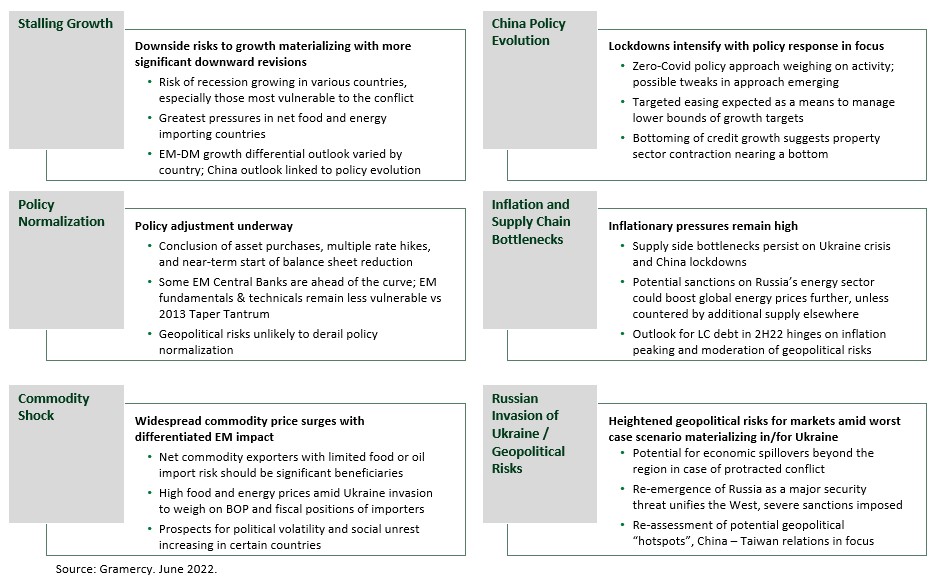
Global growth expected to stall on inflation and rates shock
A combination of high inflation exacerbated by supply constraints from the war in Ukraine as well as renewed lockdowns in China and swiftly rising interest rates to combat price pressure is likely to continue to weigh on economic and financial conditions. Global growth ex-China has been resilient through most of 1H with global PMI averaging 52 pts through May. However, annual growth forecasts have been lowered by ~80 bps since our last report to around 3% which speaks to the scope of slowdown expected as the year progresses. Global trade growth is estimated to fall from around 10% y/y in 2021 to 4% y/y in 2022.
With this being said, activity is still in part supported by pent up demand in the backdrop of nearly full removal of virus-related restrictions in major global markets, with the exception of China. While a largely zero-COVID policy persists in China with cases still lingering, we anticipate a gradual recovery in the coming quarter, possibly accompanied by incremental stimulus measures. Credit impulse data has begun to improve moderately and as such, we think a 3.5-4.5% annual growth rate is still reasonable with variability driven by the virus, zero-COVID policy, and stimulus measures.
We continue to expect net commodity exporters with low linkages to CIS and Europe, largely in Latin America and Africa, to have more resilient growth dynamics with net commodity importers to face greater headwinds. However, we do not anticipate the effects to be as large in 2H as in 1H. While not our base case, we remain vigilant for a right tail event which encompasses a resolution to supply constraints on food, fertilizer, or oil, helping to ease price pressures in the context of supportive base effects and softening demand. In this scenario, depending on timing, we see room for upside risk to current forecasts.
Exhibit 1: Global growth estimated to be on par with 2019; EM-DM differential green shoots later this year?
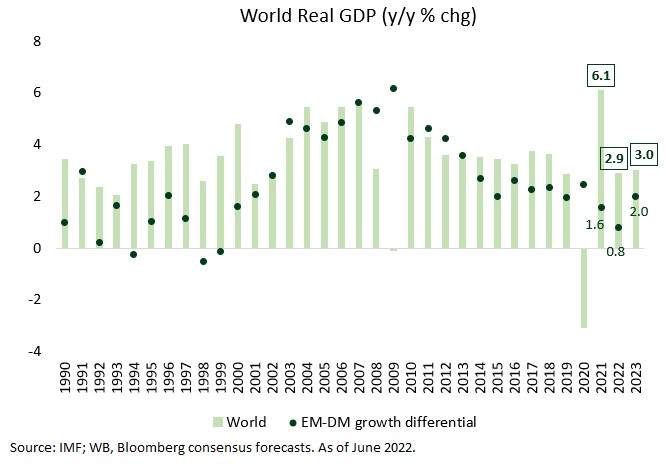
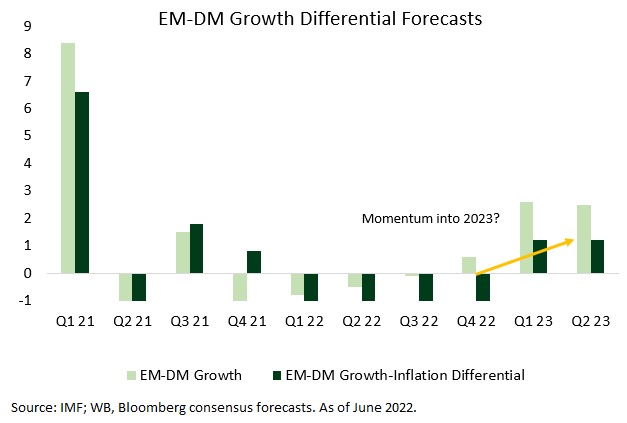
Inflationary pressures remain high; outlook subject to Ukraine conflict, China COVID policy evolution
As we wrote in our 2Q Outlook, during the early days of Russia’s invasion of Ukraine, global inflation pressures appeared set to increase further across most economies, mainly via significantly higher energy and food prices. These dynamics played out during the quarter, also supported by China’s lockdowns because of “zero-COVID” policies. Now, looking forward to 3Q, we do not see a near-term resolution to the Ukraine war, and we believe the risk of a “stop and go” economic environment in China remains high. As such, we believe that global inflation levels are likely to remain elevated in the upcoming period, anchoring a hawkish bias for central banks across DM and EM.
Incrementally tighter sanctions by the West against Russia’s energy sector/exports and retaliatory measures by the Kremlin in the form of curtailing gas supplies to Europe should keep global energy prices high, even in an environment of aggressive monetary policy tightening and slowing economic activity globally. Global food prices are also likely to remain elevated in the near-term as grain and fertilizer shortages due to the Ukraine war are unlikely to materially ease any time soon. We are skeptical about the prospects of recent international efforts brokered by Turkey to relax Russia’s naval blockade of Ukraine’s Black Sea ports and do not expect a significant improvement in Ukraine’s (and Russia’s) ability to normalize food/fertilizer exports as long as the military conflict is ongoing.
As a reminder, Russia and Ukraine account for around 25% of wheat and 20% of corn produced globally. In that context, we believe that the risks we flagged last quarter, regarding economic and social stability in already vulnerable EM jurisdictions stemming from potential bread/food shortages and rapid price increases, have likely increased further.
Major hawkish shift by DM central banks and higher terminal rates pricing in fixed income markets contribute to tighter financial conditions for EM
Reacting to spiraling inflation, central banks in both DM and EM have embarked on more aggressive than expected tightening cycles, triggering turmoil in global capital markets and a sharp deterioration in EM financial conditions. In the U.S., the release of the May inflation data and the jump in longer-term inflation expectations reported by the University of Michigan survey, prompted the Federal Reserve to deliver in June its first 75 bp increase since 1994, coming on the heels of the 50 bp hike in May and the 25 bp lift-off in March. This has led to quick market repricing of the Fed’s likely pace and terminal interest rate in the current cycle, with corresponding asset price volatility.
The FOMC’s June forecasts appear to signal that Fed policymakers believe it would be appropriate to maintain an aggressive pace of policy tightening in 3Q to combat elevated inflation. The latest dot plot of individual economic projections predicts the year-end policy rate at 3.4% versus 1.9% in March and 3.8% in 2023 (vs the 2.8% previously predicted). The latest forecast for 2024 is 3.4% (vs 2.8% previously predicted) and long run is at 2.5% (vs the 2.4% previously predicted). Even the least hawkish FOMC members have the Fed funds rate ending this year above 3%. Chair Powell’s press conference after the June policy rate decision underscored the shift in the Fed’s view to a sharp focus to implementing sufficiently “restrictive” monetary policy in order to bring inflation down to the 2% medium-term target.
Some observers believe that the Fed would be forced to react even more aggressively going forward and market expectations for U.S. monetary policy trajectory would need to adjust again. In that view, persistent underestimating of inflationary pressures over the last 12 months has eroded the Fed’s credibility and ability to anchor market expectations, which now requires more aggressive policy action to be repaired. Unless the Fed regains control of the inflation narrative, its policy transmission effectiveness could be at risk, with respective negative spillovers for the U.S. and global economies.
A more “benign” scenario for the Fed’s policy outlook hinges on factors “outside of the Fed’s control”, as highlighted by Chair Powell during his press briefing following the June rate decision. Beyond doubt, the key factors are the war in Ukraine and lockdowns related to China’s “zero-COVID” policies. The combination of a demand shock (post-COVID pent-up demand) and a massive supply shock (COVID-related supply chain bottlenecks plus the Ukraine wars’ impact on energy and food prices in quick succession) have been the main contributors to creating an incredibly powerful global inflation storm. As such, a tangible improvement in the inflation outlook will likely require a sustained unwinding of those dynamics, turning current global macro headwinds into tailwinds. In this environment, we are of the view that careful credit quality differentiation, based on deep, bottom-up fundamental analysis (one of our key themes for 2021), seems to have further increased in EM market relevance as we look toward 3Q 2022.
Ukraine conflict rages on with various spillover effects globally
The commitment by Western powers to ensure that Ukraine “wins” the war appears to remain extraordinarily strong. In that context, we expect financial and military support for Kyiv to continue, which suggest to us that fighting is unlikely to end in the near future. The respective goals and incentives of the two sides appear to point toward continuing hostilities and slim chances for ceasefire/peace talks unless a major shift in the balance of power were to occur. Despite Russia’s firepower superiority, Ukraine continues to offer fierce resistance supported by a steady flow of Western military and financial aid. Against this backdrop, the unfolding “Battle for Donbas” seems likely to continue in the coming months amid Russia’s goal to achieve control over the region and Ukraine’s determination to defend it. We think Ukraine is likely to also attempt to regain control over other Ukrainian territories that have fallen under Russian occupation, which informs our expectations for a protracted conflict.
Against this backdrop, tightening of sanctions against Russia and respective counter measures by the Kremlin remain on the table in 3Q, keeping pressures on global energy and food prices elevated. For example, a recent oil embargo by the EU is projected to result in cutting around 70% of Russian oil exports to the EU immediately and ~90% by the end of the year. In what seems to be a retaliation for Western support for Ukraine, Russia appears to have curbed gas supply to Europe in mid-June, unsettling gas markets across the continent and exacerbating the inflation outlook.
China’s response to the war, which has been under close watch by U.S. policymakers as well as investors in the context of latent tensions regarding Taiwan and further global splintering of financial, technological, and economic systems, can be characterized as playing both sides but generally benign thus far. We watch for any signs of aggression heading into the Party Congress in October. If conditions allow, China could act as a mediator in the future. While our base case remains for China to avoid any actions that blatantly violate U.S. sanctions or provoke the U.S., given their desire to maintain stability in a politically sensitive year amid growth challenges, we do not rule out developments that increase tensions. This could include more frequent Chinese military incursion into Taiwanese defense airspace, which has been a common occurrence in recent years, or deepening of China’s strategy for unification likely outlined as part of the Party Congress in October. From an economic perspective, we expect continuation of strategic de-coupling including greater de-listing risks and supply chain regionalization efforts. While there have been rumors of potential tariff relief, we think this is unlikely in a widespread or overly impactful manner given political constraints.
The most significant spillover effect from the war in Ukraine on emerging markets more broadly remains a commodity price shock and associated food and energy affordability in the context of already high inflation and rising rates. Net commodity exporters (~60% of EMBIGD) have been the outperformers as better terms of trade should help external accounts despite softer global growth. Inversely, net commodity importers, most directly dependent on Russia and Ukraine for imports, particularly those with stretched balance sheets reliant on external financing, have underperformed. Many countries have begun to unwind or better target subsidies and normalize prices in the current backdrop in aim to protect their balance sheets. As envisaged last quarter, we have not seen any widespread unconditional multilateral assistance in this backdrop but select countries have moved forward to request new IMF programs or augmentations to existing facilities as well as sourced official bilateral or private commercial support. These actions have bought some countries time, but we expect more financing will be needed, absent an improvement in the global backdrop, with focus on solutions likely to build heading into the Fall IMF meetings.
The risk of social discontent and unrest globally should remain elevated, particularly if shortages mount as the year progresses and inflation does not abate. On one hand, current conditions could contribute to furthering the growing popularity of outsiders and anti-system political candidates in elections, nearshoring of select supply chains to preserve national security, as well as attempts to decentralize and disrupt financial systems through greater use of crypto and digital currencies and non-bank platforms at the margin. On the other, the polarization and political disfunction witnessed in recent years in some select markets may begin to contribute to voter attempts to restore governability.
Exhibit 2: EM net commodity exporters benefit from fiscal and external tailwinds, all else being equal…
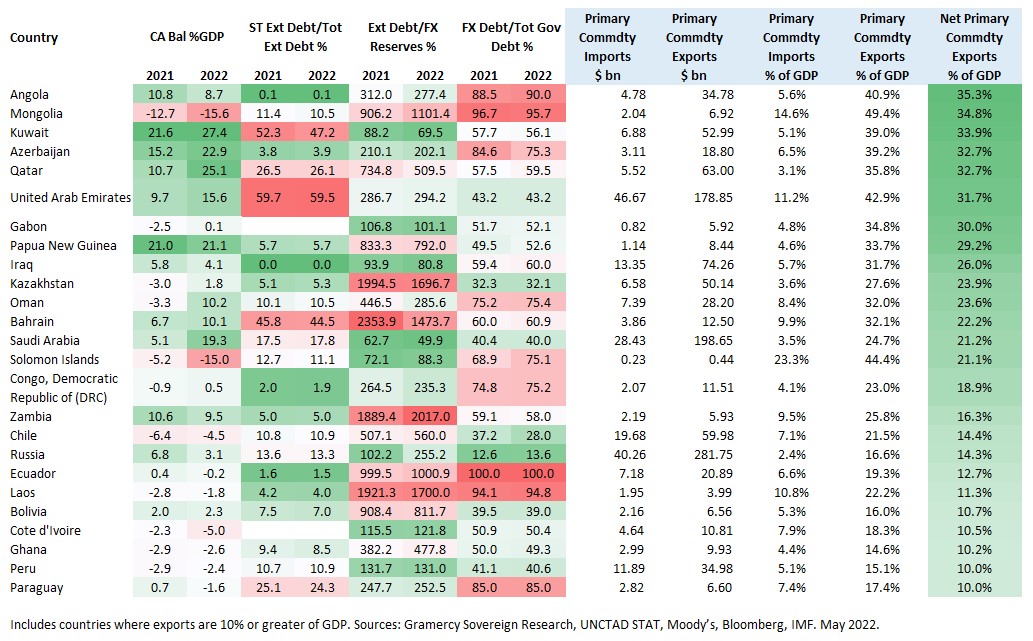
Exhibit 3: …while EM net commodity importers face additional headwinds
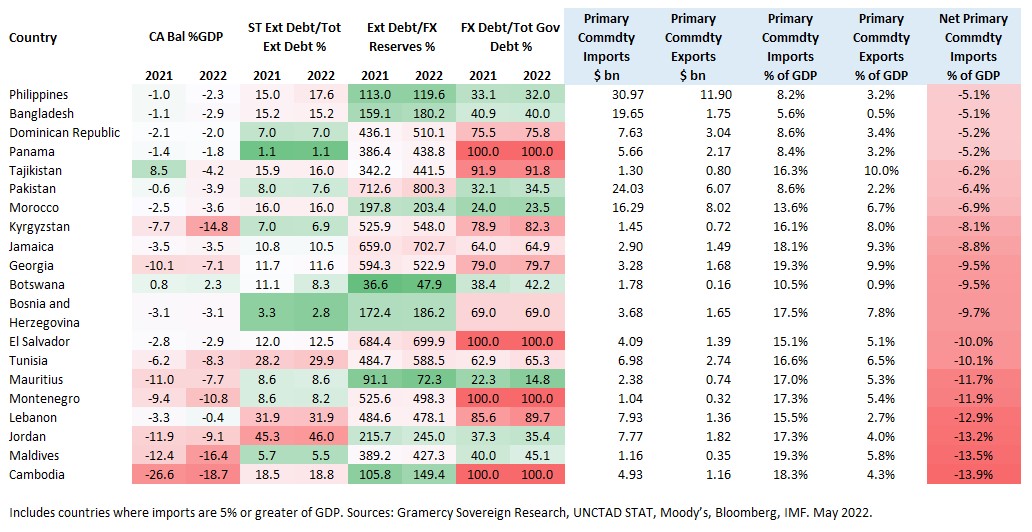
Oil prices: tight supply picture points to elevated prices even if demand declines amid DM monetary policy tightening and slower GDP growth
Even before the Russian invasion of Ukraine, oil prices were strongly supported by the post-COVID recovery in global demand and underwhelming supply driven by a muted recovery in U.S. production and an underperforming OPEC+. Severe sanctions against Russia’s financial system and energy sector have amplified the upside pressures on prices substantially. Western financial sanctions alone dramatically limited the flow of Russia’s cargoes in the open market by hamstringing key intermediaries (banks, commodity traders, tankers, etc.) from dealing with Russian exporters. A North American embargo of Russian hydrocarbons increased the reputational cost of dealing with Russian exporters. Several international majors (Exxon, Shell, BP) swiftly exited Russian real assets increasing pressure on future supplies. A subsequent European embargo of Russian hydrocarbons, an order of magnitude more significant than the North American embargo, materialized in 2Q and is projected to cut around 70% of Russian oil exports to the EU immediately and ~90% by the end of 2022.
In this backdrop, crude prices should remain close to historical highs in the near-term. For context, Russia represents ~7% of global exports. The full impact of a Western embargo on Russian oil would take a material amount of crude off global markets and, in the context of low production and tight inventories, likely support elevated prices even in a scenario of increasingly tighter monetary policy and slower GDP growth globally. We believe oil market fundamentals are supportive of high ($80 – $100/b) prices, even in a scenario of global recession. This is naturally an environment that would favor oil producers amid EM credits at the expense of importers, especially those with large net energy import bills on the external accounts, as discussed in the previous section.
Investment Strategy Review and Outlook
The market headwinds continued throughout the 2nd quarter of the year. The combination of higher inflation and interest rates lead to higher spreads and lower prices across EM credit. Exhibit 4 below shows that as the quarter comes to end, it seems interest rate and inflation fears are giving way to concerns over credit and liquidity risks. That being said, the current dislocation in EM credit rivals the largest we have seen in the past 25-30 years in emerging markets. As a result, we are observing compelling expected returns from both a top-down, historical perspective but also from a bottom-up, portfolio construction standpoint. Please see Exhibits 5 and 6 for a graphical depiction of historical market drawdowns and the potential that may exist as well as the top-down historical significance of our current environment.
Exhibit 4: Asset Class Returns

Exhibit 5: Emerging Markets Debt Drawdown Analysis
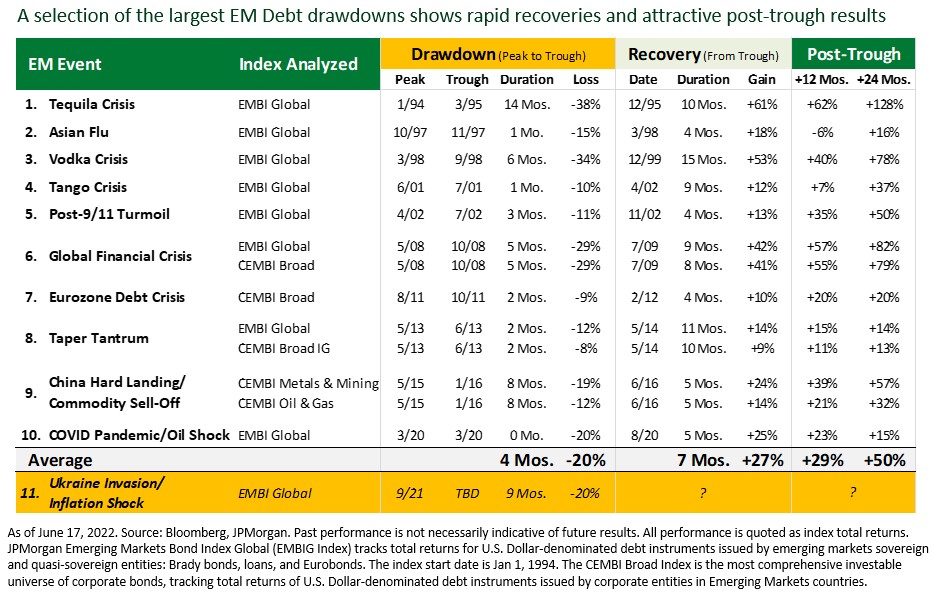
Exhibit 6: From a Top-down Perspective This is a Historic Drawdown
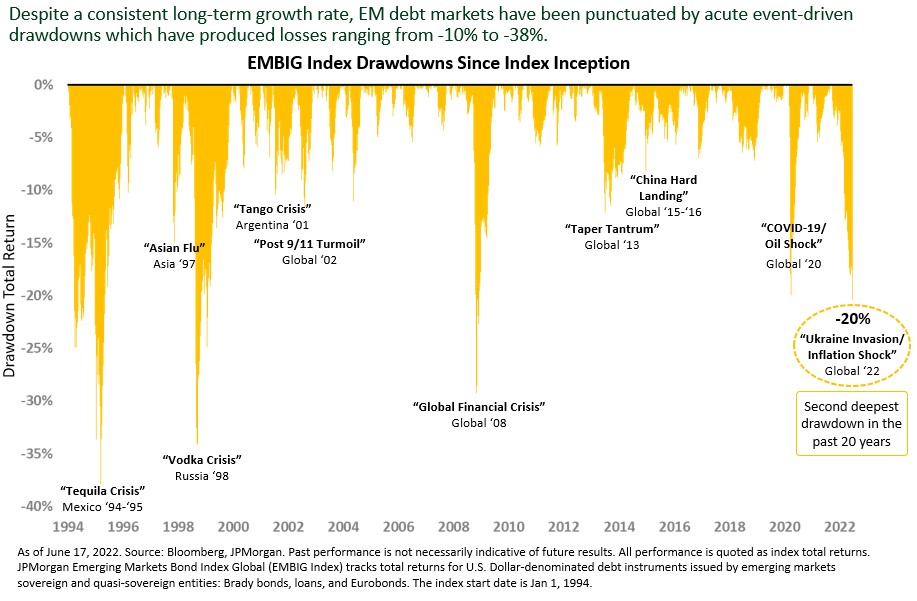
Exhibit 7 below depicts a further evaluation of these compelling expected returns based upon historical results. We believe the current dislocation is an opportunity. However, we are not simply buying the market but rather selecting expected winners based-upon the themes we discussed prior, for the most part focusing on countries and companies that are benefiting from commodity exports. Also, in 2021 and early 2022 we favored high yield (HY) corporates over investment grade (IG) sovereigns as a buffer against the higher duration of the IG’s. Now, with interest rate risk having played out and potential credit risk on the horizon, we are looking to add IG credits back into the mix. We anticipate continuing to add well collateralized, structured private credit to take advantage of high yields, strong security packages and explicit compensation for the associated illiquidity.
Exhibit 7: From a Bottom-Up Perspective We See Value Opportunities
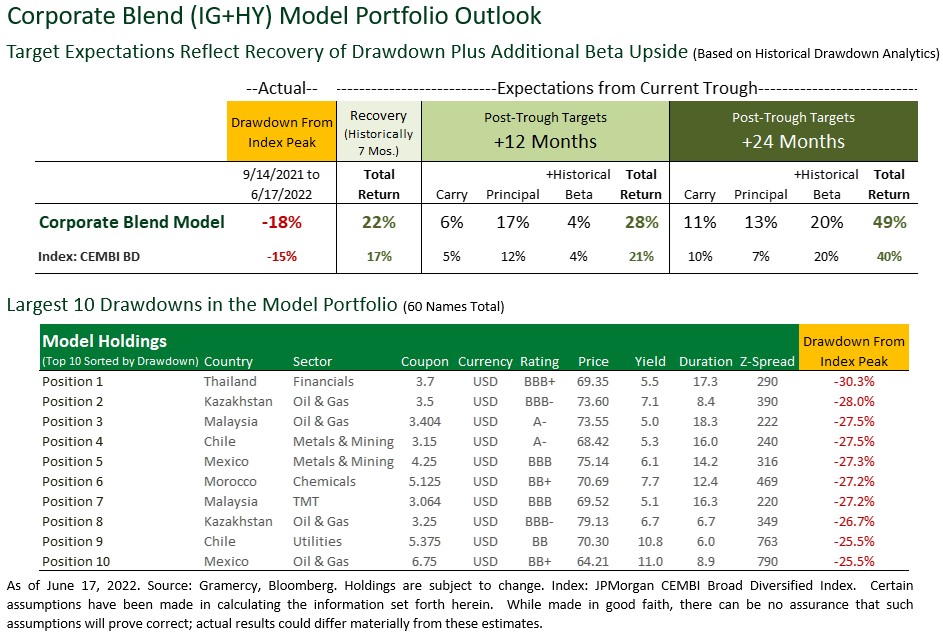
We believe that the destination (expected returns over next 1-2 years) is at the end of an attractive path. While the journey from where we stand today may be bumpy, we expect it to be worthwhile.
Eventually, we believe that coupon, current yield, YTM and pull to par will overcome the factors that have contributed to the dislocation. As such, we are confident that when we look back 1-2 years from now, the returns captured will have been worth the volatility that we may have experienced. We are cautiously leaning-in here, combining high conviction security selection, both public and private, with dynamic management of our preferred hedges, put spreads.
Emerging Markets Debt
- EM YTD performance has been significantly impacted by the tightening of global financial conditions (U.S. 10-year Treasury wider by 170 bps YTD) and general risk off sentiment on the back of “stagflation” concerns in key economies as growth decelerates.
- Performance has also been impacted by idiosyncratic events such as Russia’s invasion of Ukraine in mid-February and China’s ongoing zero-COVID policy which continues to weigh on Chinese growth and the performance of the Chinese property sector.
- In terms of returns, EM sovereigns have been hardest hit by the macro backdrop and negative risk sentiment, posting a YTD return of -19.4% vs only -13.2% for the EM corporate segment. As expected, given the significant move in rates, YTD, IG underperformed HY. The YTD return for EM IG sovereigns is -20.2% vs. -18.5% for EM HY sovereigns and the YTD return for EM IG corporates is -13.8% vs -12.4% for EM HY corporates. EM local currency is down 14.6% YTD.
- While the macro backdrop remains challenging, we are cautiously constructive on EM debt based on the level of drawdown that has already taken place YTD. Drawdowns such as these have only happened a handful of times historically, lasting only 5-6 months on average before a period of significant recovery ensues. In this environment, we believe active management is critical to manage risks and generate alpha.
-
-
- According to JPMorgan data, EM hard currency has already experienced significant outflows of more than $15bn YTD, which is in line with other drawdown periods but still short of the $27bn outflow from March 2020 (important to note, however, that 2020 had a net annual inflow of $12.6bn). EM local flows also turned negative in the second quarter, such that the YTD outflow from EM local now stands at more than $16bn.
- Going into the second half of 2022, we believe extremely compelling valuations and more supportive technicals should mitigate the potential for further outflows.
- EM corporate HY still offers 70 bps over U.S. HY (versus a 5-yr average of 39 bps) and EM sovereign HY offers 132 bps over U.S. HY (versus a 5-yr average of 116 bps).
- We expect new issuance to remain muted for the remainder of the year. Issuance YTD stands at $194bn ($141bn from EM corporates and $53bn from sovereigns). YTD corporate EM issuance is down 45% y/y and stands at the lowest level since 2016. 2022’s primary issuance forecast for EM is $537bn ($400bn corporate and $137bn sovereign). This is 22% below 2021 on a consolidated basis. Sovereign issuance is expected to be 43% lower while corporate issuance is expected to be 12% lower than in 2021.
- From a fundamental perspective, we believe EM corporates have entered 2022 with stronger balance sheets than pre-pandemic levels. EM net leverage is 1-2x lower than comparable DM with EM corporate IG and HY net leverage of 1.2x and 2.2x, respectively (vs. 2.4x and 3.8x for U.S. IG and HY, respectively). Overall corporate fundamentals should continue to improve in 2022 as EM corporates are net beneficiaries of higher commodity prices, particularly in Latin America, Middle East and Africa.
- Sovereign fundamentals on the other hand are more dispersed than corporates because there has been a transfer of resources from public to private. As a result, sovereign debt burdens have grown heavier across the board with the extent of deterioration varying depending on the scale of measures implemented and their effectiveness. Pressure on some sovereign balance sheets is likely to grow on the back of the Russia/Ukraine conflict and its impact on global commodities, while others may experience some relief. Given these factors, a greater level of differentiation will be needed for sovereigns for the remainder of the year.
-
-
- The coming quarter will be important from a global risk sentiment perspective. The push and pull between fears of a recession and fears of continued high inflation should keep rates volatile in the short-term and may keep risk sentiment muted; however, given the historic drawdown seen to date in our market, we believe that risk is skewed to the right tail over the medium-to-long run. As such, we remain cautiously constructive on strong fundamental credits that have been negatively impacted by technicals – this includes credits that benefit from higher commodity prices.
- We retain our preference for EM corporates over sovereigns, high yield over investment grade and hard currency over local currency. We note that pockets of value are forming in IG, particularly in EM corporate IG, which are providing interesting opportunities for portfolio optimization.
Alternative Credit
Our dynamic credit strategy seeks high, consistent returns throughout the credit cycle using a rotational approach to EM credit, which we believe can be achieved by deploying bottom-up security selection within cyclically favorable credit sectors. Currently, our strategy target weights are roughly: 30% performing dedicated high yield, 30% performing opportunistic high yield, 20% sovereign+, and 20% distressed. The strategy remains skewed to performing dedicated high yield (45%) and performing opportunistic high yield (20%). Amidst the market turmoil, we partially monetized our interest rate, spread and oil hedges while leaving in place tail risk hedges. We continue to look for opportunities that offer high convexity amidst the ongoing dislocation.
We believe:
-
-
-
- Commodity producers ranging from metals to energy to agriculture present attractive opportunities at dislocated prices. Specific players will continue to generate excess cash flow and, in some cases, an amount of free cash flow equivalent to their debt stack. We look for opportunities in players that are taking advantage of high commodity prices to de-lever.
- China property continues to be under stress. Weak home sales, tight regulation, recent COVID-19 outbreaks and challenging financing conditions have driven prices to distressed levels, but recoveries are likely to be substantially higher than some of the current levels suggest. Home sales are slowly improving driven by policy loosening and as financing conditions slowly improve for some select developers. Near-term catalysts include further improvement in home sales, the regulatory environment and financing conditions as well as full restructuring offers from Evergrande, which could provide some comfort to the market.
- Ukraine corporates are all undergoing varying degrees of stress, even as some have stayed current on interest payments. While it seems quite certain that all corporate bonds will need to be restructured, it seems premature to estimate what those recoveries will look like until hostilities end.
- Several project and infrastructure players took advantage of the bull market to issue well-structured, properly collateralized and fully funded project bonds. Given low issuance coupons, several have been aggressively hit in the dislocation and present attractive attachment points with decent current yields. We’re assessing the ability of various players to remain current by meeting their P90 cash flow generation profiles.
- Following the default of Alpha Credit and Credito Real, the LATAM NBFI sector presents opportunities in secured and unsecured situations. Given recurring funding needs, access to bank financing and capital markets is vital to ensure survival. We are looking for funding opportunities with the players that will be best capitalized to seize the gap left by those that lost access to funding. Conservative accounting policies will be critical for players looking for financing, as accounting scandals have preceded situations of stress.
- Several sovereigns are trading below fair value at reasonable haircuts and conservative exit yields. We are looking for attractive entry points, consensual restructuring processes and IMF support. While very high commodity prices will continue to create stress for commodity importing countries, several net exporters present compelling opportunities.
- Venezuela continues to see significant interest as the Western world pivots away from Russia and seeks new strategic energy alliances. From our perspective, the Biden Administration has taken a somewhat more constructive tone and the prospect of improved relations and, perhaps, the removal of sanctions, gives risk assets a much-needed shot in the arm.
- Despite a challenging political and macro-economic environment, IMF support sets the path for gradual fiscal consolidation and monetary financing in Argentina. Weak technicals create entry points well below fair value (even in a scenario of a second restructuring). As we head towards presidential elections in 2023 and some bonds start to pass-through some carry, the Argentine sovereign complex remains an extremely compelling opportunity set in the current environment.
-
-
Capital Solutions
Despite a very volatile 2nd quarter in the global markets, the Gramercy Capital Solutions Strategy has had an active period of deploying capital. The team closed more than eight transactions in Peru, Brazil, Mexico, Colombia and Turkey in the 2nd quarter. We find that during bouts of volatility in global markets, our business tends to benefit. When capital markets are choppy, the public markets tend to be closed to high yield or first-time issuers. Thus, we are better able to extract more favorable terms, either through enhanced structures or collateral and/or with improved economics on the deal. Also, during periods of volatility, crossover EM participants typically focus more on their home market. All of which provides what we believe is a very favorable period for EM dedicated private credit businesses, such as Gramercy.
Latin America, which is our core market for Capital Solutions, should be a beneficiary of the recent volatility. When global supply chains have caused a disruption, closer to home regions such as Latin America should benefit from more relative trade flows. Higher commodity prices benefit most Latin American economies, which we expect to pass through to many of our credits. We continue to be aware that the near-term back drop for global economic activity will be uncertain. Accordingly, we continue to scrutinize our downside projections to make sure our underwritings are sound, and our downside protection is adequate. We think this environment plays very well into private credit as we are able to create structured deals with robust collateral and covenants. One of the tangible benefits is through our covenant packages, as we can more frequently improve structure, collateral or payment terms if the economic environment deteriorates. This puts us at a unique advantage to enhance our credit quality in ‘real time’. In summary, our pipeline is robust, competition is less and our ability to extract better terms has improved.
Special Situations
The Special Situations Group has developed a robust pipeline of law firm financing opportunities. These opportunities feature an attractive return profile with a well-diversified collateral pool and limited litigation risk in many instances based on the litigation/settlement status of the underlying cases. The Special Situations Group is particularly focused on opportunities where the law firm and/or underlying case collateral has an emerging markets (mainly Latin America) nexus, but the law firm is seeking recoveries in developed market jurisdictions including the U.S. and UK. Underlying case collateral includes environmental, consumer protection, medical device and other product failure and personal injury cases. Given market conditions, we believe these types of opportunities should provide very attractive uncorrelated returns.
Aside from law firm financing opportunities, the group continues to vet several specialty finance investment opportunities. Specific opportunities currently being considered include aircraft leasing opportunities, import/export factoring and early-stage EM litigation financing arrangements, namely under ICSID and UNCITRAL.
Where possible, the Special Situations Group is utilizing insurance products for litigation finance and other investments, which creates an asymmetric risk return profile.
Multi-Asset
Our Multi-Asset Strategy came into the year well positioned with high conviction structured credit and select EMD names on one side of our barbell and opportunistic credit, special situations and a large percentage of cash on the other side. With a dislocation well advanced, we have materially reduced our hedges. This construct has performed well and now leaves us with the resilience, optionality and agility to reallocate to high return opportunities in dislocated credit, opportunistic, and special situations that have presented themselves in the first half of the year.
Conclusion
Now FOMO makes sense! History demonstrates that the current dislocation warrants prudent participation. Medium-term expected returns are hard to ignore here. Yes, the journey may be bumpy but if proper security selection is employed to respect the dispersion of outcomes that we expect, then the destination warrants the volatility. If history is any guide, waiting to identify the bottom may result in climbing the wall of worry and allocating closer to the top than the bottom a.k.a. the “grumpy trade.” As always, plan the trade and trade the plan!
About Gramercy
Gramercy is a dedicated emerging markets investment manager based in Greenwich, Connecticut with offices in London, Buenos Aires and Mexico City, and dedicated lending platforms in Mexico, Turkey, Peru, Pan-Africa, Brazil, and Colombia. The firm, founded in 1998, seeks to provide investors with attractive risk-adjusted returns through a comprehensive approach to emerging markets supported by a transparent and robust institutional platform. Gramercy offers alternative and long-only strategies across emerging markets asset classes including multi-asset, private credit, public credit, and special situations. Gramercy is a Registered Investment Adviser with the SEC and a Signatory of the Principles for Responsible Investment (PRI). Gramercy Ltd, an affiliate, is registered with the FCA.
Contact Information:
Gramercy Funds Management LLC
20 Dayton Ave
Greenwich, CT 06830
Phone: +1 203 552 1900
www.gramercy.com
Joe Griffin
Managing Director, Business Development
+1 203 552 1927
[email protected]
Investor Relations
[email protected]
This document is for informational purposes only, is not intended for public use or distribution and is for the sole use of the recipient. It is not intended as an offer or solicitation for the purchase or sale of any financial instruments or any investment interest in any fund or as an official confirmation of any transaction. The information contained herein, including all market prices, data and other information, are not warranted as to completeness or accuracy and are subject to change without notice at the sole and absolute discretion of Gramercy. This material is not intended to provide and should not be relied upon for accounting, tax, legal advice or investment recommendations. Certain statements made in this presentation are forward-looking and are subject to risks and uncertainties. The forward-looking statements made are based on our beliefs, assumptions and expectations of future performance, taking into account information currently available to us. Actual results could differ materially from the forward-looking statements made in this presentation. When we use the words “believe,” “expect,” “anticipate,” “plan,” “will,” “intend” or other similar expressions, we are identifying forward-looking statements. These statements are based on information available to Gramercy as of the date hereof; and Gramercy’s actual results or actions could differ materially from those stated or implied, due to risks and uncertainties associated with its business. Past performance is not necessarily indicative of future results. This presentation is strictly confidential and may not be reproduced or redistributed, in whole or in part, in any form or by any means. © 2022 Gramercy Funds Management LLC. All rights reserved.
